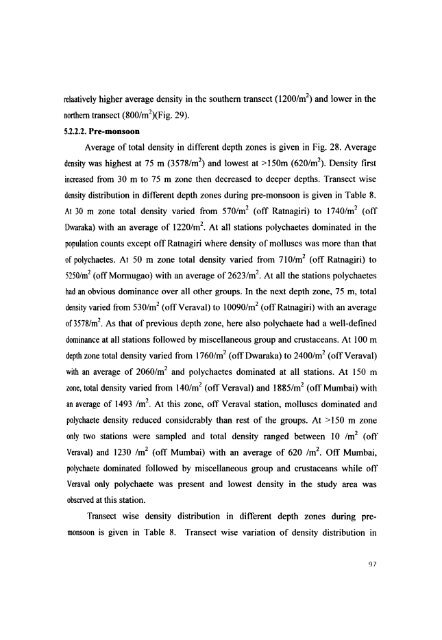L - Cochin University of Science and Technology
L - Cochin University of Science and Technology
L - Cochin University of Science and Technology
You also want an ePaper? Increase the reach of your titles
YUMPU automatically turns print PDFs into web optimized ePapers that Google loves.
elaatively higher average density in the southern transect (1200/m2) <strong>and</strong> lower in the<br />
northern transect (800/m 2 )(Fig. 29).<br />
5.2.2.2. Pre-monsoon<br />
Average <strong>of</strong> total density in different depth zones is given in Fig. 28. Average<br />
density was highest at 75 m (3578/m 2 ) <strong>and</strong> lowest at >150m (620/m 2 ). Density first<br />
increased from 30 m to 75 m zone then decreased to deeper depths. Transect wise<br />
density distribution in different depth zones during pre-monsoon is given in Table 8.<br />
At 30 m zone total density varied from 570/m 2 (<strong>of</strong>f Ratnagiri) to 1740/m 2 (<strong>of</strong>f<br />
Dwaraka) with an average <strong>of</strong> 1220/m 2 . At an stations polychaetes dominated in the<br />
population counts except <strong>of</strong>f Ratnagiri where density <strong>of</strong> molluscs was more than that<br />
<strong>of</strong> polychaetes. At 50 m zone total density varied from 710/m 2 (<strong>of</strong>f Ratnagiri) to<br />
5250/m 2 (<strong>of</strong>f Mormugao) with an average <strong>of</strong> 2623/m 2 • At all the stations polychaetes<br />
had an obvious dominance over all other groups. In the next depth zone, 75 m, total<br />
density varied from 530/m 2 (<strong>of</strong>fVeraval) to 10090/m 2 (otT Ratnagiri) with an average<br />
<strong>of</strong> 3 578/m 2 • As that <strong>of</strong> previous depth zone, here also polychaete had a wen-defined<br />
dominance at all stations followed by miscellaneous group <strong>and</strong> crustaceans. At 100 m<br />
depth zone total density varied from 1760/m 2 (<strong>of</strong>f Dwaraka) to 2400/m 2 (<strong>of</strong>TVeraval)<br />
with an average <strong>of</strong> 2060/m 2 <strong>and</strong> polychaetes dominated at all stations. At 150 m<br />
zone, total density varied from 140/m 2 (<strong>of</strong>f Veraval) <strong>and</strong> I 885/m 2 (<strong>of</strong>f Mumbai) with<br />
an average <strong>of</strong> 1493 1m 2 • At this zone, <strong>of</strong>f Veraval station, molluscs dominated <strong>and</strong><br />
polychaete density reduced considerably than rest <strong>of</strong> the groups. At > 150 m zone<br />
only two stations were sampled <strong>and</strong> total density ranged between 101m 2 (<strong>of</strong>f<br />
Veraval) <strong>and</strong> 1230 1m 2 (<strong>of</strong>f Mumbai) with an average <strong>of</strong> 620 1m 2 . Off Mumbai,<br />
polychaete dominated followed by miscellaneous group <strong>and</strong> crustaceans while <strong>of</strong>f<br />
Veraval only polychaete was present <strong>and</strong> lowest density in the study area was<br />
observed at this station.<br />
Transect wise density distribution in different depth zones during pre<br />
monsoon is given in Table 8. Transect wise variation <strong>of</strong> density distribution in<br />
97

















